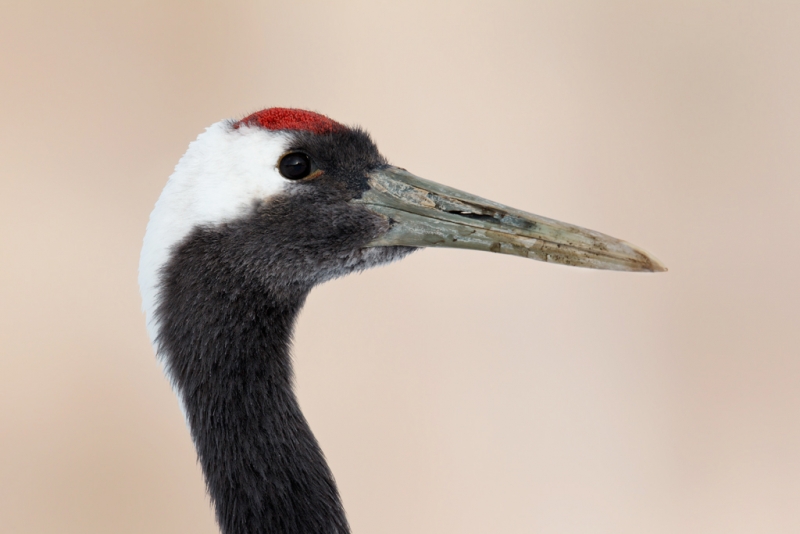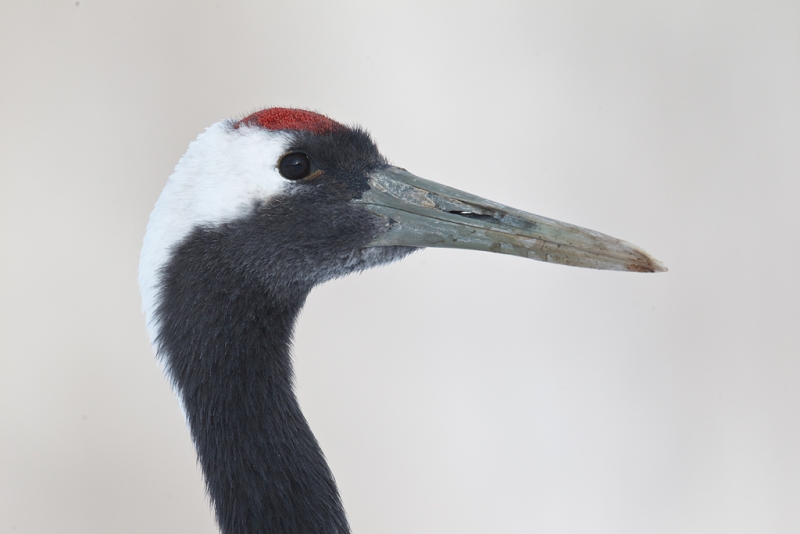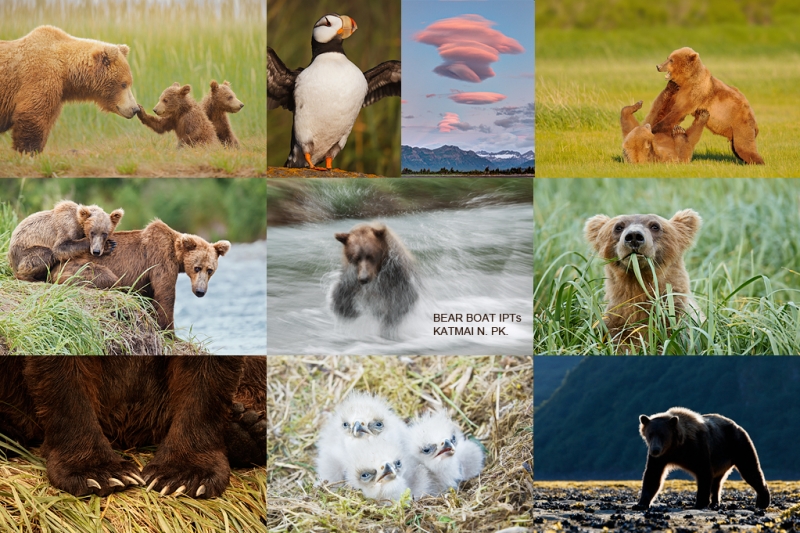|
This Red-crowned Crane head portrait was created at the Akan Crane Center with the with the tripod-mounted Canon 800mm f/5.6L IS lens, the 1.4X III TC, and the Canon EOS-1D Mark IV. ISO 400. Evaluative metering +1 2/3 stops as framed: 1/320 sec. at f/9 in Manual mode. Central Sensor/AI Servo Rear Focus on the bird’s bill and recompose. Click here if you missed the Rear Focus Tutorial. Click on the image to enjoy a larger, more spectacular version. |
A Favorite Situation
This image was made moments after I created one of my very favorite images of the Japan trip, the sleeping Red-crowned Crane featured in the blog post here. In fact, this many very well be the same bird. A guy comes out on a snowmobile every ten to fifteen minutes or so to chase off the Whooper Swans that come in to eat the grain provided for the endangered cranes. Each time he shuffles the crane deck so to speak. In any case, at the time I made this image the subject was standing in the shade of the building that is the visitor center.
Subject in shade/background in sun is one of my very favorite nature photography situations. I look for it every time I am out. If you are lucky enough to encounter the opportunity, you will-as I did hear–want to add enough light to properly expose the shaded subject while at the same time avoid over-exposing the sunlit background. As I was in Manual mode at 1/800 sec. at f/11 for the sunlit bird I first dialed up to f/9 and then rolled adjusted the shutter speed till the analog scale showed +1 2/3 stops. I made one quick image, checked the background for blinkies–there were none, and then went for a better head angle.
One thing that we do on all IPTs is to make folks aware of the types of situations that I look for. And we let them know why one situation works while another does not. When I am in the field with a big lens I spend most of my time looking. Looking for good situations. I don’t waste my time photographing junk. When I find something good, however, I make lots of images in short order….
|
This is the original capture converted with the ACR defaults. I opened NIK Color Efex Pro 4 and ran Tonal Contrast at 70% only on the bird’s dark feathers and the bill. Then I brought up the background in Viveza where I am learning to use the Control Points effectively. |
NIK 15% Discount
You can save 15% on all NIK products (including and especially Color Efex Pro 4) by clicking here and entering BAA in the Promo Code box at check-out. Then hit Apply to see your savings. You can download a trial copy that will work for 15 days and allow you to create full sized images.
NIK Creative Efex Collection
NIK recently announced the availability of a special limited production bundle of 3 of their most popular products, Color Efex Pro 4, Silver Efex Pro 2, and HDR Efex Pro. You can save more than $200 on the bundle which is available only through NIK affiliates. If you would like additional info, please e-mail with the words “Creative Efex Collection” in the Subject line. If you have been on the fence about purchasing the plug-ins mentioned above this is a great chance to save some significant bucks. I love both Color Efex Pro and Silver Efex and plan on learning to use Viveza soon.
|
Join me this summer and live on a boat for six full days of Coastal Brown (Grizzly) Bear photography. At close range. Live your dream. Great food too! Images copyright Arthur Morris & Robert O’Toole. If you are seriously interested please e-mail for itinerary and additional details. |
SELECTED IPT INFO
KATMAI BEAR BOAT IPT: July 24-31, 2012 from Kodiak, AK: $6699. Limit 6/Openings 3. Coastal Brown Bears (Grizzlies) Galore!
Coastal Brown Bears at point blank range foraging & clamming with a good chance of copulations; cubs nursing and playing. Likely additional subjects include Horned and Tufted Puffins, nesting Bald Eagle and Black-legged Kittiwake, Steller’s Sea Lion, rafts of Sea Otters and more. Halibut fishing optional
MORRO BAY, CA IPT. APR 2-4, 2012. 3-FULL DAYS: $1499. Introductory Slide program: 7pm on 4/1. Limit: 10/Openings: 2.
Please call or e-mail for late registration discount information.
Click here to learn more about this IPT.
Earn Free Contest Entries and Support both the Bulletins and the Blog by making all your B & H purchases here.
More and more folks are earning multiple contest entries with their B & H purchases. See here for details on that. Eleven great categories, 34 winning and honored images, and prize pools valued in excess of $20,000. Click here to visit the competition home page.
Shopper’s Guide
Below is a list of gear that I used to create the image in this blog post. Thanks a stack to all who have used the Shopper’s Guide links to purchase their gear as a thank you for all the free information that we bring you on the Blog and in the Bulletins. Before you purchase anything be sure to check out the advice in our Shopper’s Guide.
Canon 800mm f/5.L IS lens. Right now this is my all time favorite super-telephoto lens.
Canon EF 1.4X III TC. This new TC is designed to work best with the new Series II super-telephoto lenses.
Canon EOS-1D Mark IV professional digital camera body. My two Mark IVs are my workhorse digital camera bodies.
And from the BAA On-line Store:
LensCoats. I have a LensCoat on each of my big lenses to protect them from nicks and thus increase their re-sales value. All my big lens LensCoat stuff is in Hardwood Snow pattern.
LegCoat Tripod Leg Covers. I have four tripods active and each has a Hardwood Snow LegCoat on it to help prevent further damage to my tender shoulders 🙂 And you will love them in mega-cold weather….
Gitzo GT3530LS Tripod. This one will last you a lifetime.
Mongoose M3.6 Tripod Head. Right now this is the best tripod head around for use with lenses that weigh less than 9 pounds. For heavier lenses, check out the Wimberley V2 head.
CR-80 Replacement Foot for Canon 800. When using the 800 on a Mongoose as I do, replacing the lens foot with this accessory lets the lens sit like a dog whether pointed up or down and prevents wind-blown spinning of your lens on breezy days by centering the lens directly over the tripod.
Double Bubble Level. You will find one in my camera’s hot shoe whenever I am not using flash.
The Lens Align Mark II. I use the Lens Align Mark II pretty much religiously to micro-adjust all of my gear an average of once a month and always before a major trip. Enjoy our free comprehensive tutorial here.
Canon EOS-1D Mark IV User’s Guide. Learn to use your Mark IV the way that I use mine. Also available for the 7D and the Mark III here.
BreezeBrowser. I do not see how any digital photographer can exist without this program.


















Artie: The image is in the contest. I should go to BPN, and might even get the courage to do that one of these days!
Good and good plan and good luck. No courage needed. We are honest but gentle….
Artie: Thanks for the blog–in fact, for all the blogs. After reading it I went back to one of my own favorite tight bird images and was pleased to see that I’d put the bird’s brilliant blue eye about 2/3 of the way up the frame. That eye is the attraction for the whole photo but it just works better framing it as you describe and did. You know, when people take photos of other people they all-too-often put the heads in the middle of the frame, leaving lots of blank sky and unnecessarily cutting off parts of their subjects’ torsos. I guess I’m lucky; I never framed photos that way, even when I was a kid with a Box Brownie.
There is something invigorating and delightful about sharing photographic opportunities with other like-minded people!
Hope to see the image in the contest. If you enjoy sharing you should join the fun and learning on BPN.
OOch, OOch OUCH.
I don’t have a problem with anyone making a living from photography, nor even the high cost of photo trips (Botswana is one of the most expensive places on the planet to shoot wildlife); just with the standing in a scrum and having to fight for position – might just as well be a photojournalist!
You are right about the results though, somehow the talented photogragher’s stands out no matter what.
Thanks for understanding 🙂 artie
It’s a super image, better than the similarly framed one on the Wikipedia Red-crowned Crane page, and almost certainly for the very the reason you prefer your subjects in shade when it’s sunny. Where Petra Karstedt’s image was taken with a bright summer sun high overhead, some detail is actually lost, even though the image is pin sharp. That’s a fascinating lesson Artie, thanks.
I never really mentioned that it is the quality of light on the subject that I like most about this situation.
Hi Art,
I am relatively new to following your blog but have followed your work style for many years. I have just come back from 3 weeks in the Kalahari which at this time is full of wildlife but EMPTY OF PEOPLE – and that is my point.
Photographing wildlife is surely an opportunity to get away from “civilisation”; crowds, cellphones, computers and TV and find photographs in peace and quiet, in touch with nature…….
I for the life of me cannot understand the attraction of photographing monkies in concrete pools standing shoulder to shoulder with crowds of tourists – or even other photographers.
I cannot but hold my head in my hands when I see serried ranks of photographers all armed with the same long lenses, all taking the same photos of the same animal or bird.
How sad is that?
The same with the Sea Eagles. Wedged into a tourist boat with a crowd of rubberneck tourists where you can barely move or stand upright? Please!
Given the cost of these excursions, is there no way they could be made a little more exclusive and ‘away from it all’?
I can understand to a agree where it is a person’s living but apart from that it’s a case of thanks but no thanks.
PS Thanks to your staff for getting the sun hood to me so quickly. The temperatures reached 45C and it saved my brain from getting completely cooked.
Thanks for sharing your thoughts. Glad that the sun protection hood helped out.
Obviously deciding whether or not to enjoy the great opportunities in Japan is a personal choice, one that many 1,000s of photographers make each year. Being sad is a choice. As for your judging others you might with to visit and do The Work. My visiting had little to do with making a living; Robert and I barely broke even. Stranger still, I enjoyed the experience immensely. And obviously made lots of great images. As far as “ranks of photographers armed with the same long lenses taking the same photos of the same animal or bird” I will attribute that to ignorance; are you seeing lots of images around that look exactly like those that I created? Have you noted that each year several Japan in winter wildlife images from the locations we visited win prizes in prestigious international competitions? Please :).
ps: good photographers make images they do not take them.
The bird’s eye here is pretty much on the intersection of two rule-of-thirds point, Doug, so that’s probably influencing placement and how far down the neck.
I’ve noticed the same thing in my bird headshots, so maybe that’s what’s going on here too.
I rarely think rule of thirds with head portraits; as I mentioned to Doug below, the key is getting the eye well above the horizontal centerline. ABP II explains how to do that with various AF techniques.
Neither do I, Art- it’s instinctive.
Instinctive for you too, maybe?
Don’t think so. My instinct at the start back in 1983 was to put all the birds in the middle of the frame….
Yeah , but you’re a lot better at this game now, aren’t you?
😉
It would be an interesting exercise to look at a collection of your head shots, Art – I wouldn’t be shocked if a whole a lot of ’em are rule of thirds-ish out of the camera…
Yes, a lot lot better now. But again, if it had been instinctual I would not have put everything in the middle when I began. A fine point, but a clear point to me. Agree on the rule of thirds comment, especially after the crop 🙂 artie
I should also mention that this is one clear, and often under-appreciated, advantage of a high(er) number of AF points – the more you’ve got, the more compositional options present themselves.
I’ve “only” got 19 in my 7D, but I use any and all of them in order to get the best possible compositional result. I’ve got a pal who’s a perfectly capable photographer – used to be a pro wedding shooter – and (although he uses a 50D so is limited(?) to 9 AF points) will not get off the one in the middle, and his composition suffers as a result, meaning that he has to rely excessively on cropping in post.
This point supports your advice from APB II completely of course, and it’s just such a waste of a camera’s potential.
Yes, I was frustrated at times with only the 9 AF sensors on the 5D II. For static subjects, no big deal: rear focus AF and recompose. With moving subjects or when hand holding it was much more of a handicap. Hello 61 AF points with the 5D MIII.
Question…when creating these head portraits, do you have a guideline on how far down the neck to go?
Thanks
Doug
Sorry…one more question…as I was studying the image, I was also wondering…if you would’ve shown more neck, would’ve you’ve went vertical vs horizontal and a shorter
neck?
Doug
Yes, a bit wider and I go to vertical.
Hey Doug, From ABP II which I am pretty sure that you have:
“When creating tight head portraits, the biggest challenge involves making an image in
which the bird’s eye is placed well above the horizontal centerline. This is especially true
with folks using modern autofocus technology as photographers tend to rely too heavily
on the central sensor. They simply place it on the subject’s eye and make the image. As a
result, the eye is in the center of the frame and there is too much empty space above the
bird’s head.”
Time to hit the books 🙂